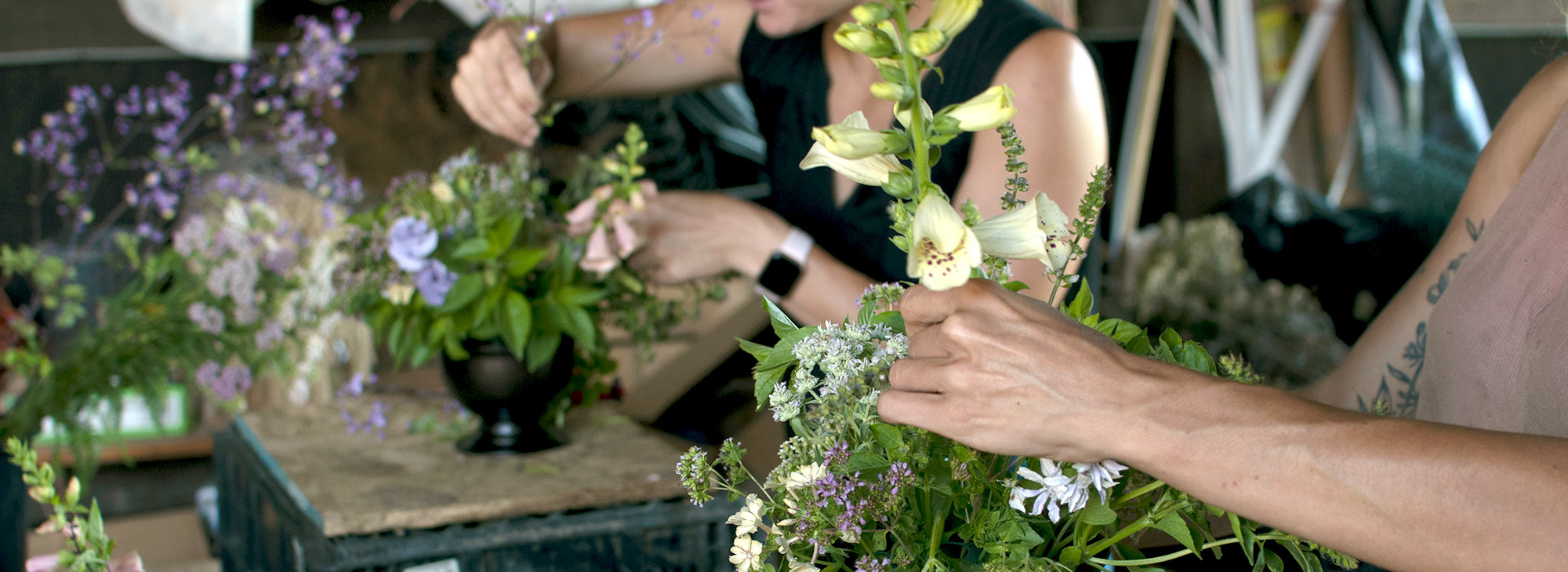The Guide to Flower Math
Surprise: there’s math behind most flower arrangements! Before you can make your masterpiece, you need to assemble your floral ingredients–and this requires planning and counting.
This Guide will help you tally up the flower stems you need for whatever DIY extravaganza you have planned. This is the same basic method that we use at our floral studio for figuring out our harvest lists when we’re making arrangements for a wedding!
Step 1: Make a List of Arrangements
You’ll need to sit down and write a list of all the flower arrangements you’d like to make.
This will include all the pieces you plan to create, from the smallest bud vases up to the biggest table centerpieces. List out the type of arrangement and the quantity you’d like to make. Leave nothing out!
Example Arrangement List
11 Mason Jar Table Centerpieces
1 Large Bouquet
3 Small Bouquets
Step 2: Write Down the Stems Needed for Each Arrangement
Next, decide how many stems you need to create each arrangement.
We’ve put together a helpful little table below to help you figure out how many flowers you’ll need for some different styles of arrangements. Most items have a range of stems, because everybody’s taste is different when it comes to how big to make an arrangement!
It can be helpful to find images showing what you have in mind for each finished arrangement. If, for example, your inspiration photo of a centerpiece arrangement is very full and lush-looking, you should estimate a higher stem count there.
| Type of Arrangement | Stems Needed |
| Small bouquet | 20-30 stems |
| Large bouquet | 50-60 stems |
| Mason Jar / Small Vase | 10-15 stems |
| Large Vase | 30-40 stems |
| Compote Centerpiece | 60-80 stems |
| Bud Vase | 3-5 stems |
| Boutonniere | 3-5 stems |
| Flower Crown | 20-30 stems |
Example Arrangement List with Stem Counts:
11 Mason Jar Table Centerpieces –> need 15 stems each
1 Large Bouquet –> need 60 stems each
3 Small Bouquets –> need 20 stems each
Step 3: Do the Flower Math
Time to do the flower math to figure out your order! For each type of arrangement you’re making, multiply out the quantity by the # of stems needed to make 1. Then, add all your totals up.
Loose Flowers come in bunches of 10 stems. So, if you need 45 stems, you should round up and order 50 stems, or 5 bunches.
Example Flower Math:
11 Mason Jar Table Centerpieces: 11 * 15 stems each = 165 stems total
1 Large Bouquet: 1 * 60 stems each = 60 stems total
3 Small Bouquets: 3 * 20 stems each = 60 stems total
——————————————————————————–
Total flowers needed: 180 + 60 + 60 = 285 stems = 29 bunches
Step 4: Break it Down by Flower Type
We offer three categories of blooms: Focal Flowers, Supporting Flowers, and Foliage. When you order, you’ll need to tell us how many bunches of each of these categories you want.
For well-rounded arrangements, we recommend ordering a mix of 25% Focal Flowers, 50% Supporting Flowers, and 25% Foliage.
Example Flower Math:
29 total bunches needed –> round up, because I like to have extra!
25% Focal Flowers = 8 bunches
50% Supporting Flowers = 15 bunches
25% Foliage = 8 bunches
Final Loose Flowers Order:
——————————–
8 bunches Focal Flowers
15 bunches Supporting Flowers
8 bunches Foliage
Step 4: Planning out your Time
A big part of a successful DIY project is time-budgeting as well as stem math. How long will it take you to make your arrangements? How many helpers will you need in order to get everything done on time?
The chart below shows approximately how long it could take one person to make each type of arrangement listed. Of course, this timing will vary widely based on your experience level, general speed of working, and level of perfectionism.
| Type of Arrangement | Time Needed to Make 1 |
| Small bouquet | 20 – 40 minutes |
| Large bouquet | ~1 hour |
| Mason Jar / Small Vase | 10 – 20 minutes |
| Large Vase | 30 – 40 minutes |
| Compote Centerpiece | 30 – 60 minutes |
| Bud Vase | ~5 minutes |
| Boutonniere | 10-15 minutes |
| Flower Crown | ~1 hour each |
Use this as a starting point, and we encourage you to round up your time estimate–it’s always better to be done early than to be working late right before your wedding!
Using the same strategy as above, multiple out the arrangements you plan to make with your time estimates for each one. Then, you can decide how many friends you need to recruit in order to make it all happen.
Example Time Estimates:
11 Mason Jars * 10 minutes each = ~2 hours
1 Large Bouquet * 1 hour each = 1 hour
3 Small Bouquets * 20 minutes each = 1 hour
——————————————————————————–
Total time needed: about 4 hours
The plan: I’ll recruit one friend to do the mason jars while I do the bouquets, and together we’ll be done in 2 hours! We’ll do this on Friday afternoon before the rehearsal dinner.
Need Some Help?
If you’re feeling overwhelmed by the numbers, we can help! We offer DIY consultation calls for $75, and we’ll help you do all your flower math, as well as recommend any tools or supplies we think you’ll need in order to complete your project.
Email flowers@seachange.farm to book your consultation call.
